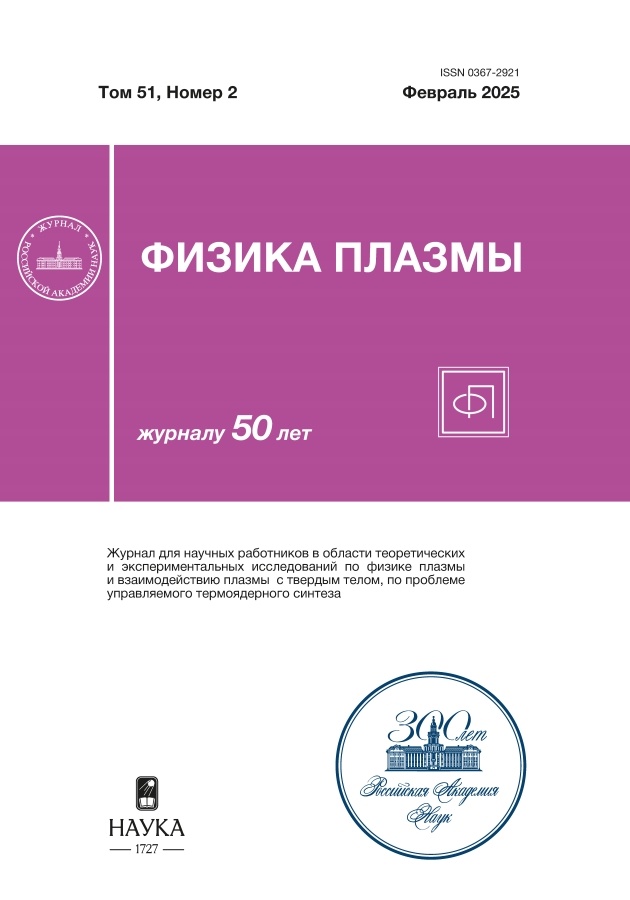AUTOWAVE SWITCHING IN THE LIGHTNING CHANNEL
- 作者: Iudin D.I.1,2
-
隶属关系:
- Gaponov-Grekhov Institute of Applied Physics, Russian Academy of Sciences
- Volga Region Research Medical University
- 期: 卷 51, 编号 2 (2025)
- 页面: 223-234
- 栏目: LOW TEMPERATURE PLASMA
- URL: https://freezetech.ru/0367-2921/article/view/686403
- DOI: https://doi.org/10.31857/S0367292125020099
- EDN: https://elibrary.ru/GAILQR
- ID: 686403
如何引用文章
详细
Lightning is represented as a multistable system demonstrating the ability to self-regulation by maintaining its own electroneutrality. Within the framework of the description of the lightning channel using telegraphic equations, a nonlinear parabolic equation is obtained for the nonlinear voltage dependence of the rate of change of the plasma cord charge. The analysis of the model shows that the lightning channel alternately develops in one of two modes, each of which is characterized by damping of the longitudinal current from one end of the lightning to the other. The transition between the modes is realized by excitation of a fast switching wave. Lightning development within each mode is accompanied by recharging of the leader system sheath and movement of the point of zero charge of the sheath (called the lightning reversal point) in the direction of longitudinal current growth. The movement of the reversal point is caused by the change of the mean potential of the discharge tree in the process of sheath recharge and explains the observed dynamics of lightning transients.
作者简介
D. Iudin
Gaponov-Grekhov Institute of Applied Physics, Russian Academy of Sciences; Volga Region Research Medical University
Email: iudin@ipfran.ru
Nizhny Novgorod, Russia; Nizhny Novgorod, Russia
参考
- Iudin D.I., Syssoev A.A., Rakov V.A. // Radiophysics and Quantum Electronics. 2021. V. 64. P. 867. https://doi.org/10.1007/s11141-022-10178-z
- Rakov V.A. // Surveys Geophys. 2013. V. 34. № 6. P. 701. https://doi.org/10.1007/s10712-013-9230-6
- Pantuso J.G., da Silva C.L. // J. Geophys. Res.: Atmospheres. 2024. V. 129. P. 1–24. https://doi.org/10.1029/2024JD041596
- Zhu Y., Bitzer P., Rakov V., Stock M., Lapierre J., DiGangi E. et al. // Geophys. Res. Lett. 2021. V. 48. P. e2021GL096714. https://doi.org/10.1029/2021GL096714
- Urbani M., Montanya` J., van der Velde O., Arcanjo M., Lo` pez J. // Geophys. Res. Lett. 2022. V. 49. P. e2021GL097272.
- Rakov V., Uman M., Thottappillil R. J. Geophys. Res. 1994. V. 99. P. 10745.
- Mazur V., Ruhnke L.H. // J. Geophys. Res. 1993. V. 98. P. 12913. https://doi.org/10.1029/93JD00626
- Mazur V., Ruhnke L.H. // J. Geophys. Res. 1998. V. 103(D18). P. 23299. https://doi.org/10.1029/98JD02120
- Mazur V., Ruhnke L.H. // J. Geophys. Res. Atmos. 2014. V. 119. P. 23299. https://doi.org/10.1002/2013JD020494
- Qie X., Pu Y., Jiang R., Sun Z., Liu M., Zhang H., Li X., Lu G., Tian Y. J. Geophys. Res.: Atmospheres. 2017. V. 122. P. 586.
- Qie X., Yuan S., Zhang H., Jiang R., Wu Z., Liu M., Sun Z., Pu Y., Li J., Srivastava A., Ma Z., Lu G. // Earth Planetary Phys. 2019. V. 3. P. 102.
- da Silva C.L., Sonnenfeld R.G., Edens H.E., Krehbiel P.R., Quick M.G., Koshak W.J. // J. Geophys. Res.: Atmospheres. 2019. V. 124. P. 9442. https://doi.org/10.1029/2019JD030693
- da Silva C.L., Winn W.P., Taylor M., Aulich G.D., Hunyady S.J., Eack K.B. et al. // Geophys. Res. Lett. 2023. V. 50. P. e2023GL105041. https://doi.org/10.1029/2023GL105041
- Bazelyan J.M., Raizer Y.P. // Physics of lightning and lightning protection. Moscow: Fizmatlit, 2001.
- Iudin D.I. // Atmospheric Res. 2021. V. 256. P. 1. https://doi.org/10.1016/j.atmosres.2021.105560
- Williams E.R., Heckman S. // J. AerospaceLab. 2012. V. 5. P. 1.
- Baum C., Baker L. New York: Hemisphere, 1990. P. 17.
- Rakov V.A., DeCarlo B.A. // J. Geophys. Res.: Atmospheres. 1998. V. 103. P. 1879.
- Bazelyan J.M., Raizer Y.P. Lightning Physics and Lightning Protection. Bristol, Philadelphia: Institute of Physics Publishing, 2000.
- Raizer Y.P. Gas discharge physics. Dolgoprudny: Publishing House “Intelligence”, 2009.
- Bazelyan E.M., Raizer Y.P., Aleksandrov N.L. // Plasma Sources Science and Technology. 2008. V. 17. P. 024015. https://doi.org/10.1088/0963-0252/17/2/024015
- Loskutov A.Y., Michailov A.S. Introduction into synergetics. Moscow: NAUKA Publishers, 1990.
- Gallimberti I., Bacchiega G., Bondiou-Clergerie A., Lalande P. // Comptes Rendus Physique. 2002. V. 3. P. 1335. https://doi.org/10.1016/S1631-0705(02)01414-7
- Marshall T.C., McCarthy M.P., Rust W.D. // J. Geophys. Res. 1995. V. 100. P. 7097. https://doi.org/10.1029/95JD00020
- Ding Z., Rakov V.A., Zhu Y., Tran M.D. // J. Geophys. Res.: Atmospheres. 2020 V. 125. № 23. P. e2020JD033305. https://doi.org/10.1029/2020JD033305
- Pu Y., Cummer S.A. // Geophys. Res. Lett. 2019. V. 46. P. 13556. https://doi.org/10.1029/2019GL085635
- Jiang R., Yuan S., Qie X., Liu M., Wang D. // Geophys. Res. Lett. V. 49. https://doi.org/10.1029/2021GL096846
- Horton R. // Geological Society of America Bulletin. 1945. V. 56(3). P. 275. https://doi.org/10.1130/0016-7606(1945)56[275:EDOSAT]2.0.CO
- Strahler A. // Geological Society of America Bulletin. 1952. V. 38. P. 1117.
- Strahler A. Eos, Transactions American Geophysical Union. 1957. V. 38. P. 913.
补充文件









